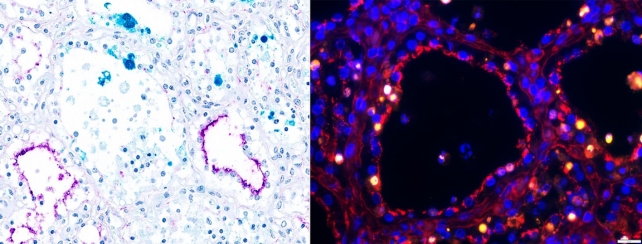ARTICLE AD
The potential of the avian flu to jump from birds to cows to humans has some scientists greatly concerned.
That very scenario has already occurred twice in the United States since the spring of 2024 – when the first cows in the nation began to fall ill with highly pathogenic avian influenza (HPAI).
Researchers at Iowa State University have now led a study on two dairy cows in Texas that were infected with the H5N1 strain to better understand how these transmissions came about.
In the respiratory tissue and mammary glands of both infected cows, the team found receptors used by a whole host of flu strains, including those that originate in birds, pigs, and even humans.
With all those receptors hanging out together, it's possible that if a virus infects a cell, it can 'learn its secrets' and mutate to attach to other receptors on the cell as well, such as those commonly found in humans.
While bird flu is deadly among avians, it seems to drive a sharp, short-lived, and non-lethal drop in milk production when it infects cows. Dairy cows in the US are the first confirmed cows to have been infected globally, and experts still don't know how the virus, which evolved to infect birds, is spreading from cow to cow.
The new study points to the milking process as a mechanism of spread. It identifies H5N1-friendly receptors in cow mammary glands, which helps explain the virus's unusual impact on the animals' milk.
Dairy workers say the milk looks thick and discolored when a cow is infected, and if the milk is raw and unpasteurized, scientists suspect it is a source of transmission for other mammals, including ourselves.
High levels of the H5N1 virus have been found in contaminated cow milk, according to officials at the US Centers for Disease Control and Prevention (CDC). However, they note, "sporadic human infections with no ongoing spread will not change the CDC risk assessment for the US general public, which CDC considers to be low."
Thankfully, the two dairy workers in the US who caught the H5N1 virus from dairy cows experienced only minor symptoms and recovered without infecting anyone else, but the pathogen that infected them did show concerning signs of adaptation to mammal bodies when analyzed by scientists.
Whether those adaptations occurred in the dairy cows or the dairy workers is unknown, but scientists at Iowa State are keen to find out more.
Influenza A viruses, like H5N1, are known to infect cells via receptors made of sialic acids. Those viral strains that evolved to infect birds prefer certain sialic acid receptors compared to those that evolved to infect mammals. Even down to the species level, influenza A viruses are quite specific about where they attach to cells.
Researchers at Iowa State University and the University of Georgia are worried by the expression and distribution of sialic acids they found in the respiratory tract and mammary glands of dairy cows infected with H5N1.
Both locations seem to be susceptible to avian influenza, and they show signs of harboring possible viral replication.
 Microscope images of mammary gland tissue from a dairy cow infected with H5N1. On the left, cells infected with influenza are turquoise and flu receptors are magenta. On the right, infections are bright yellow and receptors are bright red. (Christopher Siepker and Tyler Harm/Iowa State University)
Microscope images of mammary gland tissue from a dairy cow infected with H5N1. On the left, cells infected with influenza are turquoise and flu receptors are magenta. On the right, infections are bright yellow and receptors are bright red. (Christopher Siepker and Tyler Harm/Iowa State University)Like coronavirus, the influenza virus is "inherently error-prone," the authors write, adding that "infection of new host species gives the virus additional opportunities to replicate and subsequently mutate to be better adapt to novel hosts."
"The spread of [influenza A virus] to tissues outside of the respiratory tract is rare," writes the team of researchers.
They think it is possible that the mildly acidic environment in the cow mammary gland, coupled with the presence of sialic acid receptors, could predispose cows to H5N1 infection.
These hypotheses should be studied further, but the findings underline the "urgent need" to understand how the avian influenza virus is infecting so many mammal species.
It's also an important reminder to consumers to always drink pasteurized milk.
The study was published in Emerging Infectious Diseases.

 4 months ago
32
4 months ago
32 

